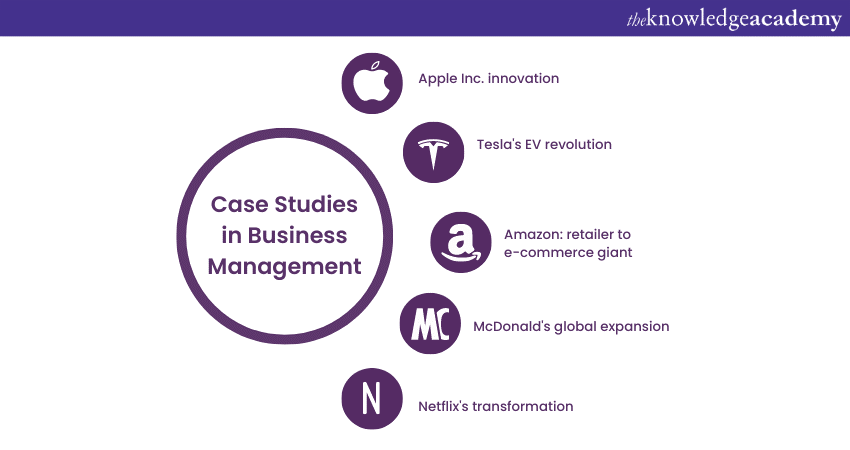We may not have the course you’re looking for. If you enquire or give us a call on +0800 780004 and speak to our training experts, we may still be able to help with your training requirements.
Training Outcomes Within Your Budget!
We ensure quality, budget-alignment, and timely delivery by our expert instructors.

Case studies play a pivotal role in understanding real-world challenges, strategies, and outcomes in the ever-evolving field of Business Management. This blog dives into the intricacies of a compelling Business Management Case Study, dissecting its components to extract valuable insights for aspiring managers, entrepreneurs, and students alike. Learn the study behind some of the most significant Business Management Case Studies & how an online business degree can help you learn more in this article.
Table of Contents
1) What is Business Management?
2) Case Studies in Business Management
a) Apple Inc. Innovation
b) Tesla’s EV revolution
c) Amazon retailer to e-commerce giant
d) McDonald’s global expansion
e) Netflix’s transformation
3) Conclusion
What is Business Management?
Business Management refers to the set of activities, strategies, and practices employed to oversee and coordinate an organisation's operations, resources, and personnel to achieve specific goals and objectives. It encompasses a wide range of responsibilities to ensure an organisation's efficient and effective functioning across various functional areas.
Try our Business Case Training Course today and start your career!
Case Studies in Business Management
Here are some of the notable case studies in the field of Business Management that have garnered attention due to their complexity, innovative strategies, and significant impact on their respective industries:

Apple Inc. innovation
a) Background: Apple Inc. is a global technology giant noted for its innovative products and design-driven approach. In the early 2000s, Apple faced intense competition and declining market share. The company needed to reinvent itself to remain relevant and competitive.
b) Problem statement: Apple's challenge was revitalising its product line and regaining market leadership while navigating a rapidly changing technological world.
c) Analysis of the situation: The Case Study dives into Apple's design thinking and customer-centric innovation to develop products that seamlessly blend form and function. The company's focus on user experience, ecosystem integration, and attention to detail set it apart from its competitors.
d) Proposed solutions: Apple's strategy involved launching breakthrough products like the iPod, iPhone, and iPad that redefined their respective markets. The company also invested heavily in creating a robust ecosystem through iTunes and the App Store.
e) Chosen strategy: Apple's commitment to user-centred design and innovation became the cornerstone of its success. The strategy encompassed cutting-edge technology, minimalist design, and exceptional user experience.
f) Implementation process: Apple's implementation involved rigorous research and development, collaboration among various teams, and meticulous attention to detail. The company also established a loyal customer base through iconic product launches and marketing campaigns.
g) Results and outcomes: Apple's strategy paid off immensely, leading to a resurgence in its market share, revenue, and brand value. The company's products became cultural touchstones, and its ecosystem approach set new standards for the technology industry.
Tesla’s EV revolution
a) Background: Tesla, led by Elon Musk, aimed to disrupt the traditional automotive industry by introducing electric vehicles (EVs) that combined sustainability, performance, and cutting-edge technology.
b) Problem statement: Tesla faced challenges related to the production, scalability, and market acceptance of electric vehicles in an industry dominated by internal combustion engine vehicles.
c) Analysis of the situation: This Case Study examines Tesla's unique approach, which combines innovation in electric powertrains, battery technology, and software. The company also adopted a direct-to-consumer sales model, bypassing traditional dealership networks.
d) Proposed solutions: Tesla's solutions included building a network of Supercharger stations, developing advanced autonomous driving technology, and leveraging over-the-air software updates to improve vehicle performance and features.
e) Chosen strategy: Tesla focused on high-quality engineering, creating a luxury brand image for EVs, and promoting a community of passionate supporters. The company also bet on long-term sustainability and energy innovation beyond just manufacturing cars.
f) Implementation process: Tesla faced production challenges, supply chain issues, and scepticism from traditional automakers. The company's determination to continuously refine its vehicles and technology resulted in incremental improvements and increased consumer interest.
g) Results and outcomes: Tesla's innovative approach catapulted it into the forefront of the EV market. The Model S, Model 3, Model X, and Model Y gained popularity for their performance, range, and technology. Tesla's market capitalisation surged, and the company played a significant part in changing the perception of electric vehicles.
Amazon retailer to e-commerce giant
a) Background: Amazon started as an online bookstore in the 1990s and quickly expanded its offerings to become the world's largest online retailer. However, its journey was riddled with challenges and risks.
b) Problem statement: Amazon faced difficulties in achieving profitability due to its aggressive expansion, heavy investments, and price competition. The company needed to find a way to sustain its growth and solidify its position in the e-commerce market.
c) Analysis of the situation: This Case Study explores Amazon's unique business model, which prioritises customer satisfaction, convenience, and diversification. The company continuously experimented with new ideas, services, and technologies.
d) Proposed solutions: Amazon's solutions included the introduction of Amazon Prime, the Kindle e-reader, and the development of its third-party seller marketplace. These initiatives aimed to enhance customer loyalty, expand product offerings, and increase revenue streams.
e) Chosen strategy: Amazon's strategy revolved around long-term thinking, customer obsession, and a willingness to invest heavily in innovation and infrastructure, even at the expense of short-term profits.
f) Implementation process: Amazon's implementation involved building a vast network of fulfilment centres, investing in advanced technology for logistics and supply chain management, and expanding its services beyond e-commerce into cloud computing (Amazon Web Services) and entertainment (Amazon Prime Video).
g) Results and outcomes: Amazon's strategy paid off as it transformed from an online bookstore to an e-commerce behemoth. The company not only achieved profitability but also diversified into various sectors, making Jeff Bezos the richest person in the world for a time.
McDonald’s global expansion
a) Background: McDonald's is one of the world's largest and most recognisable fast-food chains. The Case Study focuses on the company's global expansion strategy and challenges in adapting to diverse cultural preferences and market conditions.
b) Problem statement: McDonald's challenge was maintaining its brand identity while tailoring its menu offerings and marketing strategies to suit different countries' preferences and cultural norms.
c) Analysis: The Case Study analyses McDonald's localisation efforts, menu adaptations, and marketing campaigns in different countries. It explores how the company balances standardisation with customisation to appeal to local tastes.
d) Solutions and outcomes: McDonald's successfully combines global branding with localized strategies, resulting in sustained growth and customer loyalty in various markets. The Case Study demonstrates the importance of understanding cultural nuances in international business.
Netflix’s evolution
a) Background: Netflix started as a DVD rental-by-mail service and became a leading global streaming platform. The Case Study explores Netflix's strategic evolution, content production, and influence on the entertainment industry.
b) Problem statement: Netflix's challenge was transitioning from a traditional DVD rental business to a digital streaming service while competing with established cable networks and other streaming platforms.
c) Analysis: The Case Study analyses Netflix's shift to online streaming, its investment in original content production, and its use of data analytics to personalise user experiences and content recommendations.
d) Solutions and outcomes: Netflix's strategic pivot and focus on content quality and user experience contributed to its dominance in the streaming market. The Case Study illustrates how embracing digital disruption and customer-centric strategies can drive success.
Conclusion
These case studies offer valuable insights into different facets of Business Management, including innovation, strategic decision-making, customer-centric approaches, and market disruption. Analysing these cases provides aspiring managers and entrepreneurs with real-world examples of how effective strategies, risk-taking, and adaptability can lead to remarkable success in the dynamic business world.
Try our Business Analyst Training today for a rewarding career!
Frequently Asked Questions
Upcoming Business Skills Resources Batches & Dates
Date
 Management Training for New Managers
Management Training for New Managers
Fri 6th Dec 2024
Fri 14th Feb 2025
Fri 16th May 2025
Fri 25th Jul 2025
Fri 29th Aug 2025
Fri 10th Oct 2025
Fri 28th Nov 2025







 Top Rated Course
Top Rated Course



 If you wish to make any changes to your course, please
If you wish to make any changes to your course, please


